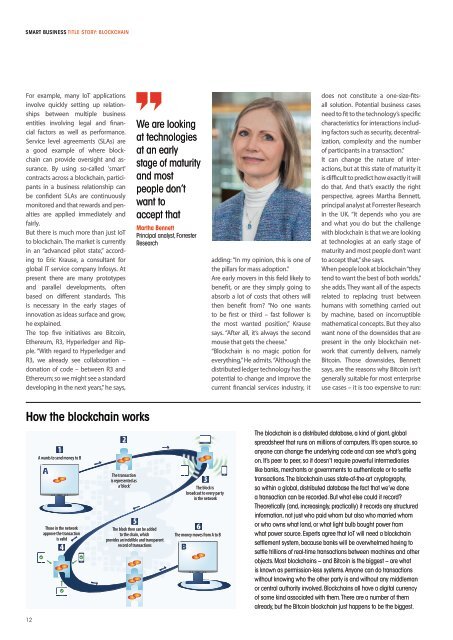Smart Industry 1/2017
Smart Industry 1/2017 - The IoT Business Magazine - powered by Avnet Silica
Smart Industry 1/2017 - The IoT Business Magazine - powered by Avnet Silica
Create successful ePaper yourself
Turn your PDF publications into a flip-book with our unique Google optimized e-Paper software.
<strong>Smart</strong> Business Title Story: Blockchain<br />
For example, many IoT applications<br />
involve quickly setting up relationships<br />
between multiple business<br />
entities involving legal and financial<br />
factors as well as performance.<br />
Service level agreements (SLAs) are<br />
a good example of where blockchain<br />
can provide oversight and assurance.<br />
By using so-called 'smart'<br />
contracts across a blockchain, participants<br />
in a business relationship can<br />
be confident SLAs are continuously<br />
monitored and that rewards and penalties<br />
are applied immediately and<br />
fairly.<br />
But there is much more than just IoT<br />
to blockchain. The market is currently<br />
in an “advanced pilot state,” according<br />
to Eric Krause, a consultant for<br />
global IT service company Infosys. At<br />
present there are many prototypes<br />
and parallel developments, often<br />
based on different standards. This<br />
is necessary in the early stages of<br />
innovation as ideas surface and grow,<br />
he explained.<br />
The top five initiatives are Bitcoin,<br />
Ethereum, R3, Hyperledger and Ripple.<br />
“With regard to Hyperledger and<br />
R3, we already see collaboration –<br />
donation of code – between R3 and<br />
Ethereum; so we might see a stand ard<br />
developing in the next years,” he says,<br />
We are looking<br />
at technologies<br />
at an early<br />
stage of maturity<br />
and most<br />
people don’t<br />
want to<br />
accept that<br />
Martha Bennett<br />
Principal analyst, Forrester<br />
Research<br />
adding: “In my opinion, this is one of<br />
the pillars for mass adoption.”<br />
Are early movers in this field likely to<br />
benefit, or are they simply going to<br />
absorb a lot of costs that others will<br />
then benefit from? “No one wants<br />
to be first or third – fast follower is<br />
the most wanted position,” Krause<br />
says. “After all, it’s always the second<br />
mouse that gets the cheese.”<br />
“Blockchain is no magic potion for<br />
everything,” He admits. “Although the<br />
distributed ledger technology has the<br />
potential to change and improve the<br />
current financial services industry, it<br />
does not constitute a one-size-fitsall<br />
solution. Potential business cases<br />
need to fit to the technology’s specific<br />
characteristics for interactions including<br />
factors such as security, decentralization,<br />
complexity and the number<br />
of participants in a transaction.”<br />
It can change the nature of interactions,<br />
but at this state of maturity it<br />
is difficult to predict how exactly it will<br />
do that. And that’s exactly the right<br />
perspective, agrees Martha Bennett,<br />
principal analyst at Forrester Research<br />
in the UK. “It depends who you are<br />
and what you do but the challenge<br />
with blockchain is that we are looking<br />
at technologies at an early stage of<br />
maturity and most people don’t want<br />
to accept that,” she says.<br />
When people look at blockchain “they<br />
tend to want the best of both worlds,”<br />
she adds. They want all of the aspects<br />
related to replacing trust between<br />
humans with something carried out<br />
by machine, based on incorruptible<br />
mathematical concepts. But they also<br />
want none of the downsides that are<br />
present in the only blockchain network<br />
that currently delivers, namely<br />
Bitcoin. Those downsides, Bennett<br />
says, are the reasons why Bitcoin isn’t<br />
generally suitable for most enterprise<br />
use cases – it is too expensive to run:<br />
How the blockchain works<br />
A wants to send money to B<br />
<br />
1<br />
Those in the network<br />
approve the transaction<br />
is valid<br />
4<br />
<br />
<br />
2<br />
The transaction<br />
is represented as<br />
a ‘block’<br />
5<br />
The block then can be added<br />
to the chain, which<br />
provides an indelible and transparent<br />
record of transactions<br />
3<br />
The block is<br />
broadcast to every party<br />
in the network<br />
6<br />
The money moves from A to B<br />
The blockchain is a distributed database, a kind of giant, global<br />
spreadsheet that runs on millions of computers. It’s open source, so<br />
anyone can change the underlying code and can see what’s going<br />
on. It’s peer to peer, so it doesn’t require powerful intermediaries<br />
like banks, merchants or governments to authenticate or to settle<br />
transactions. The blockchain uses state-of-the-art cryptography,<br />
so within a global, distributed database the fact that we’ve done<br />
a transaction can be recorded. But what else could it record?<br />
Theoretically (and, increasingly, practically) it records any structured<br />
information, not just who paid whom but also who married whom<br />
or who owns what land, or what light bulb bought power from<br />
what power source. Experts agree that IoT will need a blockchain<br />
settlement system, because banks will be overwhelmed having to<br />
settle trillions of real-time transactions between machines and other<br />
objects. Most blockchains – and Bitcoin is the biggest – are what<br />
is known as permission-less systems. Anyone can do transactions<br />
without knowing who the other party is and without any middleman<br />
or central authority involved. Blockchains all have a digital currency<br />
of some kind associated with them. There are a number of them<br />
already, but the Bitcoin blockchain just happens to be the biggest.<br />
12

















